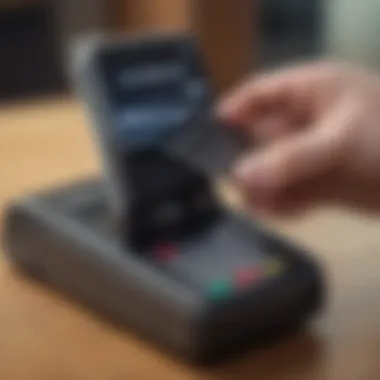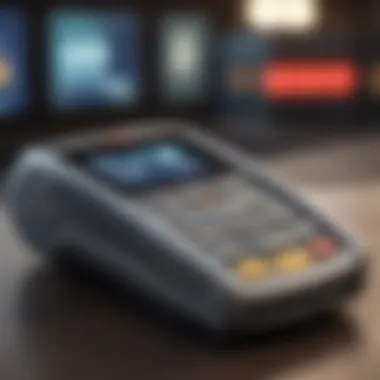Understanding Contactless Card Readers: Their Technology & Use


Intro
Contactless card readers have become increasingly relevant in our daily transactions. They simplify payments by allowing consumers to make purchases swiftly and securely. With the growing reliance on digital solutions for financial needs, understanding the technology behind these devices is essential. This overview aims to highlight how contactless side cards work and their strategic importance in the financial ecosystem.
Overview of Financial Product
Definition
Contactless card readers operate using radio-frequency identification (RFID) or near-field communication (NFC) technology. This allows the reader to communicate with a contactless card or mobile device simply when they are in proximity.
Key Features
- Speed: Transactions are completed in seconds.
- Convenience: No need to swipe or insert cards.
- Security: Often come with encryption that protects data.
- Compatibility: Work with various payment methods like debit, credit, and mobile wallets.
Purpose and Benefits
The primary purpose of contactless card readers is to facilitate secure and fast payments. They enhance the shopping experience as customers can pay quickly without handling cash or physical contact with the device. For businesses, these devices reduce transaction time, leading to higher customer satisfaction and potentially increased sales.
Types of Contactless Card Readers
Hardware Variants
Contactless card readers can be categorized into different types based on their technology and application.
- Standalone POS Terminals: Common in retail settings.
- Mobile Card Readers: Used by vendors and small businesses.
- Integrated Payment Systems: Found in smartphones and dedicated payment apps.
Situational Uses
Generally, contactless cards are employed in various situations.
- Retail environments: Fast-paced transactions like grocery shopping.
- Public transport: For ease of fare payments without cash.
- Restaurants: Streamlined checkout processes for diners.
Security Considerations
While contactless payments offer convenience, there are some security concerns.
Potential Vulnerabilities
- Data interception: Hackers could theoretically intercept signals between cards and readers.
- Unauthorized transactions: Cases of lost or misplaced cards leading to unapproved charges.
Mitigation Strategies
It’s advisable to use additional security measures.
- Two-factor authentication for mobile payment apps.
- Regular monitoring of account statements to catch any unauthorized use.
End
Understanding how contactless card readers function is vital in today's fast-changing payment landscape. Their benefits cannot be underestimated, despite potential risks. With the correct precautions, they can greatly enhance the consumer experience while ensuring security.
Intro to Contactless Card Readers
In the evolving landscape of financial transactions, contactless card readers represent a significant leap in convenience and efficiency. These devices enable users to conduct purchases or access services without the need for physical contact. This section will explore the definition of contactless card readers and their modern importance in transactions, thus laying the groundwork for comprehending the entire domain of contactless payment technology.
Definition of Contactless Card Readers


Contactless card readers are devices that allow for transactions using radio frequency identification (RFID) or Near Field Communication (NFC) technology. Users simply need to hold their contactless cards or devices near the reader to initiate a payment or transaction. This method bypasses traditional swiping or inserting processes, making it quicker for both merchants and consumers.
Contactless card readers often have an antenna for sending and receiving signals, enabling them to communicate with payment devices. These devices can read cards equipped with RFID chips or smartphones that support NFC features. The convenience of this method of payment has made it increasingly popular in various sectors, including retail, public transportation, and more.
Importance in Modern Transactions
The significance of contactless card readers in today’s payment ecosystem cannot be overstated. Their advantages include:
- Speed and Efficiency: Transactions take less time compared to cash or traditional credit card methods. Customers can complete payments in seconds.
- User Experience: The elimination of physical contact appeals to consumers seeking convenience. The user-friendly interface facilitates faster processing, enhancing the overall shopping experience.
- Health Considerations: Following health concerns related to surface contact, contactless payments have become a favorable option, promoting safer transaction practices.
- Increased Adoption: Many businesses are integrating contactless technology due to its demand. From small vendors to large retailers, businesses see customer preference towards quick and easy payment solutions.
The broader implementation of contactless technology signifies an overall shift in consumer behavior regarding payment methods, highlighting the adaptability and relevance of such innovations.
In summary, understanding contactless card readers is essential for grasping modern transaction dynamics. As the world moves towards a more digital landscape, the relevance of this technology will continue to increase.
How Contactless Card Readers Function
Contactless card readers play an instrumental role in the heart of modern payment systems. Understanding their functioning is vital for grasping the efficiency and convenience they bring to transactions. Contactless technology facilitates rapid exchanges without the need for physical contact, which aligns well with the current demand for swift and secure payment methods. In this section, we will delve into how these devices operate and the various components that aid in their functionality.
Basic Working Principle
At the core of contactless card readers lies the principle of electromagnetic induction. When a contactless card or device comes within proximity of the reader, data transmission occurs via radio waves. This exchange can happen typically within a range of 4 inches or less. The card is equipped with a secure chip and antenna that communicate with the reader's antenna and process unit. The transaction is initiated as soon as the card is near the reader, which makes it faster than traditional methods that require swiping or inserting cards.
Key benefits offered by this technology include:
- Speed: Transactions are completed nearly instantaneously, reducing physical queue time.
- Convenience: Users can tap their card on the reader, eliminating other steps.
- Reduced Wear and Tear: There is no physical insertion, which minimizes damage to cards.
However, the efficiency of this system relies heavily on the proper functioning of its components. This leads us to explore the individual parts of a contactless card reader.
Components of a Contactless Reader
Antennas
Antennas are crucial for ensuring effective communication between the card and the reader. The antenna generates and receives the radio frequency signals necessary for data transfer. One key characteristic of antennas is their ability to transmit these signals over short distances, which is essential in preventing unauthorized access.
A benefit of having specialized antennas is their compact design, allowing them to be integrated into various devices without taking up too much space. Moreover, these antennas are generally designed to withstand daily usage, ensuring longevity. However, the limitation lies in their dependency on physical alignment; if the card is not positioned correctly, communication may fail, causing delays during transactions.
Microcontrollers
Microcontrollers are the brains of the contactless reader, processing the data received from the antenna. They execute commands based on the information exchanged during a transaction. A key feature is their ability to perform numerous operations simultaneously, which is vital for maintaining fast service.
Choosing microcontrollers with low power consumption can significantly enhance energy efficiency, making them effective in various settings. However, their complexity may also result in higher costs and potential challenges in programming compared to simpler alternatives.
Power Supply
Power supply systems are essential for the operation of contactless card readers. They provide the necessary energy to run the device and its components, ensuring they function consistently and reliably. A characteristic aspect of modern power supply units is their adaptability; many can operate on varying voltage levels, which is advantageous in global markets.
The unique feature is the integration of energy harvesting technology in some suppliers, allowing them to capture ambient energy. This can enhance the sustainability of the device. Yet, irregular power input may lead to performance inconsistencies, which could disrupt transactions.
Key Technologies Behind Contactless Payments
Contactless payment systems rely on advanced technologies that streamline transactions, ensuring speed and security. Understanding these technologies is essential for users and businesses that wish to adopt and leverage them effectively. The two dominant technologies employed in contactless card readers are Near Field Communication (NFC) and Radio Frequency Identification (RFID). Each of these offers unique benefits and applications, shaping the landscape of modern payments.
Near Field Communication (NFC)
NFC is a short-range wireless technology that facilitates communication between devices positioned close together, typically within a few centimeters. This close proximity is a deliberate design choice that enhances security and reduces the risk of accidental transactions or data interception.


Key Features of NFC:
- User Convenience: NFC transactions are swift, allowing consumers to complete purchases within seconds. Users simply need to tap their contactless cards or smartphones against the reader, minimizing the duration spent at checkouts.
- Bidirectional Communication: Unlike other one-way communication technologies, NFC supports two-way communication. This feature allows not only for payment but also for data exchange, such as loyalty program updates or ticket validation.
- Security Protocols: NFC incorporates advanced encryption techniques. This is critical in protecting sensitive data from being intercepted during the transaction.
NFC technology has become increasingly prevalent in mobile wallets, such as Apple Pay and Google Pay. These platforms enable users to store multiple cards in one application, further simplifying the payment process. For instance, when a user stores numerous payment cards, NFC allows them to select which card to use right at the checkout.
Radio Frequency Identification (RFID)
RFID technology uses electromagnetic fields to automatically identify and track tags attached to objects. The tags contain electronically stored information, which is read by an RFID reader. This technology is used broadly across various industries, including logistics, healthcare, and retail.
Key Features of RFID:
- Remote Scanning Capability: RFID does not require direct contact or line-of-sight to function. This characteristic allows users to make payments without having to approach the reader closely, providing even greater efficiency in high-traffic scenarios.
- Scalability: RFID systems can handle a large number of transactions simultaneously. This property is particularly useful in settings like public transportation where many users may be tapping their cards within a short time frame.
- Wide Applications: Beyond payments, RFID is used for inventory management, access control, and even in events tracking. Its versatility makes it a valuable technology across diverse sectors.
The User Experience
The user experience with contactless card readers is critical to understanding their growing adoption in various sectors. As people increasingly rely on digital transactions, ease of use directly influences consumer satisfaction and transaction speed. Potential users should appreciate how simple and efficient it is to make payments. This aspect also facilitates faster service in busy environments, enhancing overall customer satisfaction. Additionally, the user experience encompasses the accessibility and convenience of using these devices over traditional payment methods.
How to Use a Contactless Card Reader
Using a contactless card reader is straightforward. First, ensure that your card or device is compatible. Then, simply hold it close to the reader, usually within four centimeters. You do not need to swipe or insert anything. After a brief moment, a confirmation signal indicates that the transaction has gone through, generally seen as a light or sound.
This simplicity improves the transaction flow, particularly in retail settings, making it suitable for both customers and merchants. As a result, it minimizes queue times, enabling an efficient payment experience.
Common Use Cases
Retail Transactions
Retail transactions are perhaps the most visible application of contactless technology. This method allows customers to pay quickly at stores. The key characteristic of retail transactions is speed. Customers enjoy a seamless checkout experience, making it a very popular choice. Additionally, it reduces the need for physical contact, which became even more valued in recent years due to health concerns. The unique feature of retail transactions is that they often involve loyalty programs, which can be integrated easily with contactless payments, providing further value to customers and retailers alike.
Public Transport
Public transport systems are increasingly employing contactless card readers as a means of payment. This implementation significantly speeds up the boarding process for buses, trains, and trams. The key characteristic of public transport payments is convenience. Commuters can use a single card for multiple types of transit, reducing the hassle of carrying cash or multiple tickets. The unique feature here is the integration of different transport modes under one system. While this greatly benefits users, there can be challenges if the technology fails or if there are interoperability issues between systems.
Mobile Payments
Mobile payments represent another essential use case for contactless technology. Instead of a card, users can simply tap their mobile device on the reader. The key characteristic of mobile payments is flexibility. Users can store multiple payment methods on their devices, allowing them to choose how to pay effortlessly. This approach caters to the growing demand for digital wallets like Google Pay or Apple Pay.
However, reliance on mobile payments can come with disadvantages. Not all users feel comfortable using their smartphones for transactions due to security concerns, which can hinder adoption. Furthermore, battery life becomes a critical factor as running out of power may leave customers without a payment option.
Overall, the user experience with contactless card readers is shaped by convenience, speed, and accessibility, making these systems integral to modern payment solutions.
Security Features and Concerns
The realm of contactless card readers holds paramount importance when discussing security features and concerns. As the adoption of contactless payments increases, understanding the safeguards that protect user data becomes crucial. In this section, we will explore various encryption methods employed by contactless card readers, alongside potential risks associated with their use. By addressing both the strengths and vulnerabilities present in these systems, we provide a balanced perspective on the security landscape surrounding contactless transactions.
Encryption Methods
Encryption serves as the first line of defense in safeguarding transactions made through contactless card readers. These methods transform sensitive data into a coded format. This makes it unreadable to unauthorized parties. The usage of encryption ensures that even if data is intercepted during transmission, it remains protected.
Common methods include AES (Advanced Encryption Standard) and RSA (Rivest-Shamir-Adleman). AES is widely preferred for its speed and security. RSA, on the other hand, uses asymmetric encryption which adds an additional layer of safety. Together, they help maintain the integrity and confidentiality of data exchanged between the card and the reader.
In contactless payment systems, such encryption processes occur almost instantaneously. This enables users to complete transactions quickly while ensuring their information stays secure. Thus, encryption methods play a critical role in empowering consumers to use contactless cards with confidence.
Potential Risks


Skimming Attacks
Skimming attacks represent a significant threat within the contactless payment ecosystem. This method allows criminals to capture information from contactless cards without the cardholder's knowledge. The characteristic appeal of skimming lies in its discreet nature. Attackers can use handheld devices that mimic legitimate readers to collect data within close proximity to unsuspecting individuals.
One unique feature of skimming attacks is their ability to function silently. This lack of immediate detection means users may only realize their information is compromised when unauthorized transactions occur. The primary advantage for criminals is the ease of access to data. However, advancements in card technology, such as dynamic data authentication, aim to mitigate these risks by making skimming more difficult.
Unauthorized Transactions
Unauthorized transactions pose another pressing concern for contactless card users. This refers to instances where transactions occur without the cardholder’s consent. Such events may take place due to compromised card data, sometimes resulting from previous skimming attacks. Users may struggle to contest these transactions, particularly if they are unaware of their occurrence until long after they have happened.
The key characteristic of unauthorized transactions is their potential to lead to significant financial loss. Relying solely on consumer vigilance may not be enough to prevent these incidents. Therefore, increased awareness about security measures and transaction monitoring is essential for users. The unique feature of this risk lies in its broad impact; unauthorized transactions can affect both individuals and businesses, undermining trust in contactless payment systems.
In summary, understanding the security features and concerns associated with contactless card readers illuminates the complexities of modern payment systems. While encryption methods provide necessary protection, users must also be wary of risks like skimming attacks and unauthorized transactions, which highlight the ongoing battle between security and vulnerability in the evolving landscape of contactless payments.
Regulatory Standards and Compliance
Regulatory standards and compliance play a crucial role in the functionality and acceptance of contactless card readers. These guidelines ensure that payment systems prioritize security, efficiency, and trustworthiness. Understanding these standards is vital for businesses, developers, and consumers alike.
One significant aspect of regulatory compliance is the establishment of a unified framework. This framework governs how payments are processed, ensuring their smooth function across different platforms and regions. Compliance with these standards increases consumer confidence, which is an essential element in gaining widespread adoption of contactless payment technology. Furthermore, adherence to regulatory requirements can help prevent fraud and maintain data security. Companies that neglect these aspects may be subject to penalties or loss of reputation.
Global Standards Overview
The global landscape of payment regulations is intricate. Various organizations and authorities set standards to guide manufacturers, service providers, and financial institutions in the development and execution of contactless payment systems.
- ISO/IEC 14443: This international standard defines the communication protocols used by contactless smart cards. It helps ensure compatibility in devices across different manufacturers.
- EMV Specification: Developed by EMVco, this standard focuses on payment security and is essential for chip-based transactions. Compliance ensures that payments made with contactless technology meet strict security requirements.
- NIST Cybersecurity Framework: While primarily focused on the U.S., this framework provides guidelines for managing cybersecurity risks, which can be important for contactless reader manufacturers to follow.
Future Trends in Payment Technology
The landscape of payment technology is in constant evolution. Understanding the future trends in this domain is crucial as it shapes the way consumers and businesses interact with financial systems. With advancements in technology, contactless payment solutions are becoming more prevalent. These trends offer various benefits, such as increased convenience, speed of transactions, and improved security features.
Advancements in Contactless Payment Solutions
The advancement of contactless payment solutions is replacing traditional methods quickly. Technologies like Near Field Communication (NFC) and Radio Frequency Identification (RFID) contribute significantly to this growth. As smartphones and smartwatches become commonplace, they now enable users to make payments simply by tapping their devices. This seamless interaction enhances customer satisfaction and business efficiency.
Businesses leverage these sophisticated solutions to streamline operations. They save both time and costs by reducing the queuing at checkouts. Furthermore, the use of contactless payments helps in managing cash flow more effectively.
Integration with Emerging Technologies
Blockchain
Blockchain technology presents a robust backbone for the future of contactless payments. Its decentralization is a key characteristic, ensuring that data is secure and transactions are transparent. This feature fosters trust among users, making it a beneficial option for modern payment systems.
Blockchain provides unique advantages such as immutability and real-time settlement. Transactions recorded on a blockchain cannot be altered, which significantly reduces fraud. However, the technology also has disadvantages, like scalability issues and energy consumption, which could impact its widespread adoption in contactless payments.
Artificial Intelligence
Artificial Intelligence (AI) is another emerging technology that has begun to influence payment systems. AI plays a critical role in analyzing transaction data, allowing companies to offer personalized experiences to their customers. This characteristic of AI makes it a popular choice, as it can help in targeting specific user needs effectively.
Moreover, AI can improve security in payment systems through advanced fraud detection methods. By identifying unusual patterns, AI systems can alert users or businesses about potential threats promptly. Nevertheless, the reliance on AI also raises concerns about data privacy and algorithm biases, which requires careful consideration in its application.
As technology progresses, contactless payments will increasingly integrate with innovative solutions that enhance transaction efficiency and security, ensuring that consumers and businesses remain protected and satisfied.
Finale
In this article, the exploration of contactless card readers has provided a comprehensive understanding of their essential role in modern payment systems. As consumer behavior shifts towards quicker and more efficient transaction methods, contactless technology seems to cater to these needs effectively. It is not just a matter of convenience; the implications of these systems extend to security, regulatory compliance, and evolving technology integration.
Summary of Key Points
- Contactless card readers work primarily on NFC and RFID technologies, allowing seamless transactions.
- The user experience is designed for speed, with minimal effort required to complete a payment.
- Security is a major consideration, as encryption and robust standards help mitigate risks.
- Regulatory compliance ensures that manufacturers and service providers adhere to necessary guidelines, safeguarding consumers' interests.
- Future trends indicate a growing integration of advanced technologies like blockchain and artificial intelligence with contactless payment systems.
Final Thoughts on Contactless Technologies
The advancements in contactless technologies signify more than just a trend; they represent a fundamental shift in how financial transactions are conducted. For young professionals, families, and students alike, understanding the functionality and benefits of these systems is crucial. It is vital to stay informed about their potential benefits and associated risks. Being proactive in adopting these technologies can enhance personal and business financial interactions. As we move forward, the landscape of payments is bound to evolve, shaped significantly by contactless solutions.



